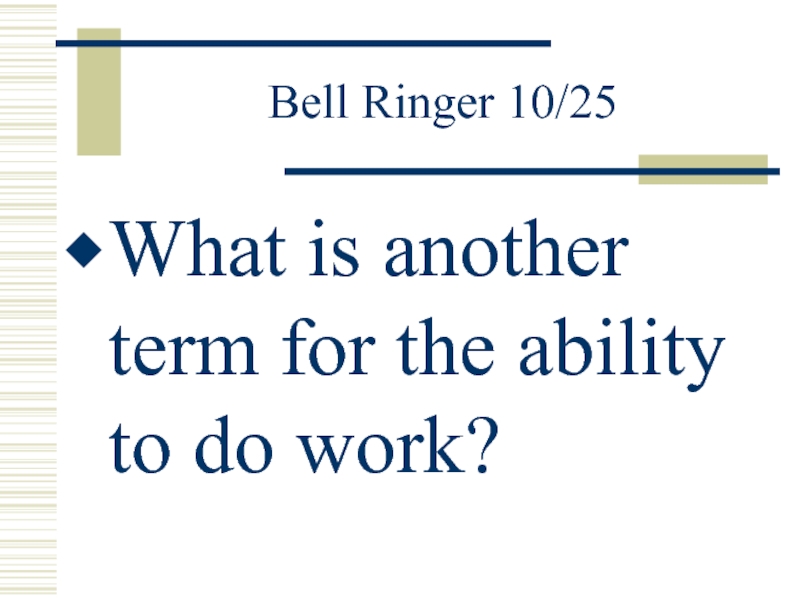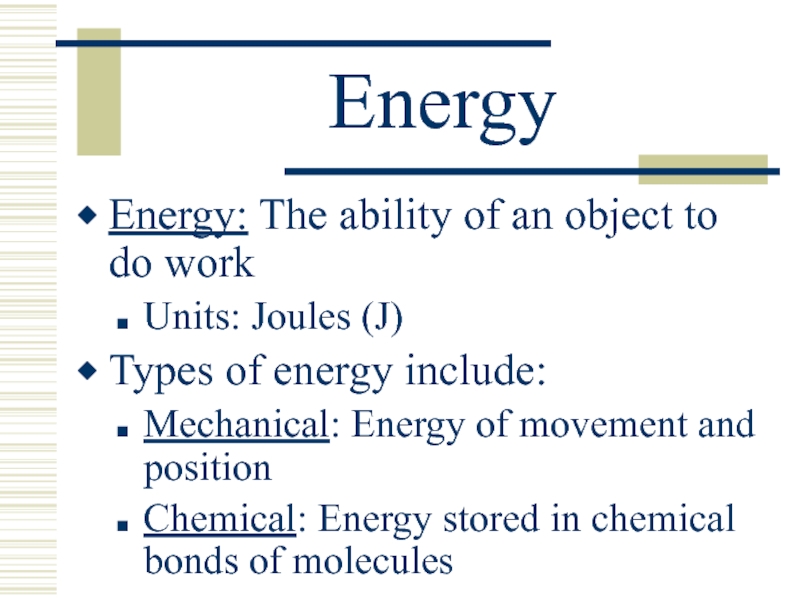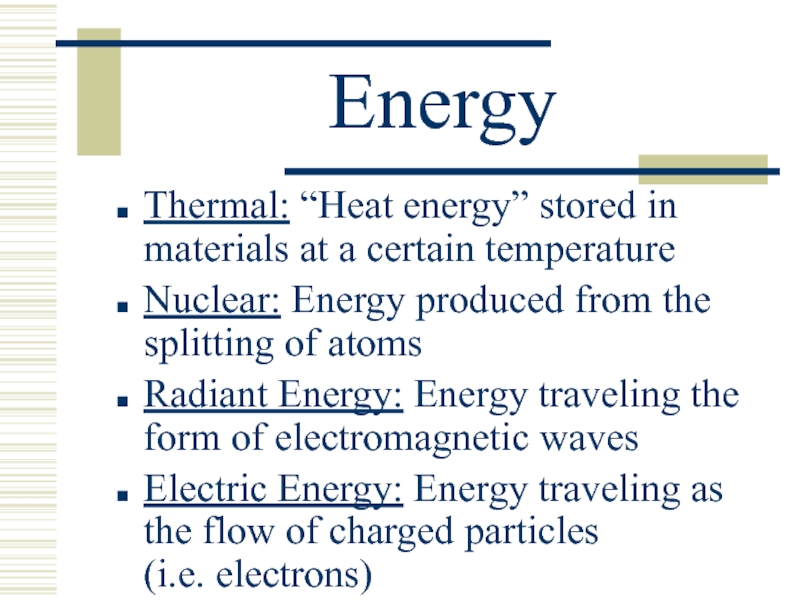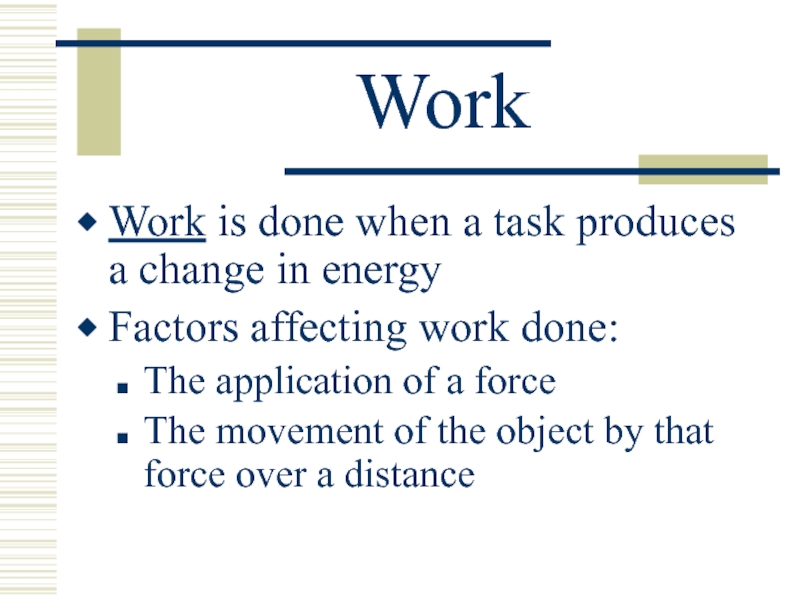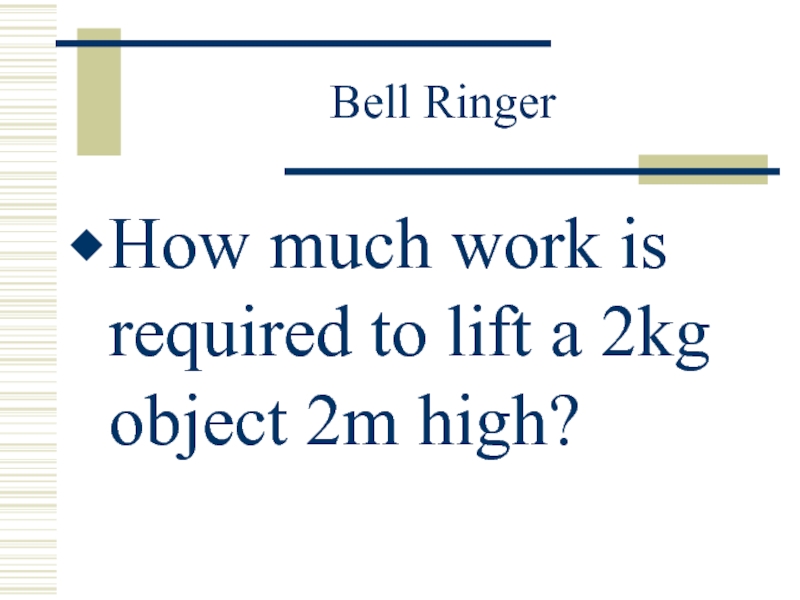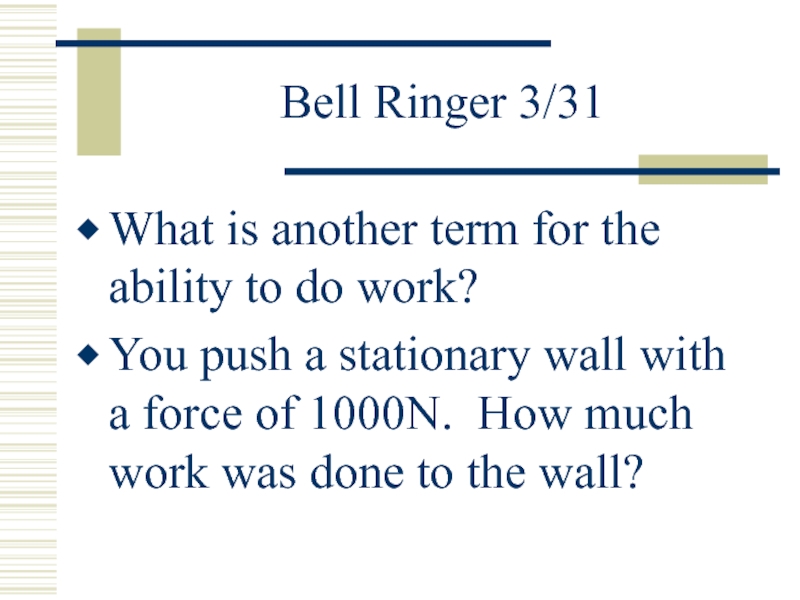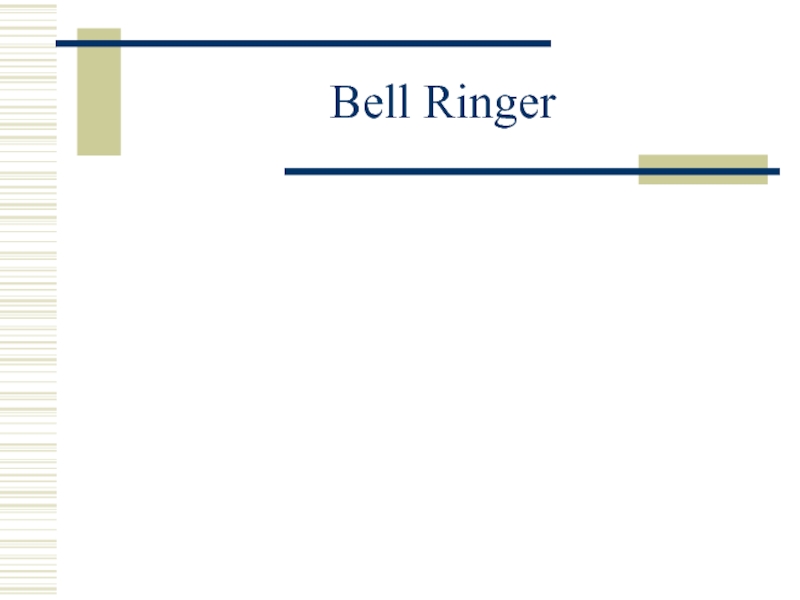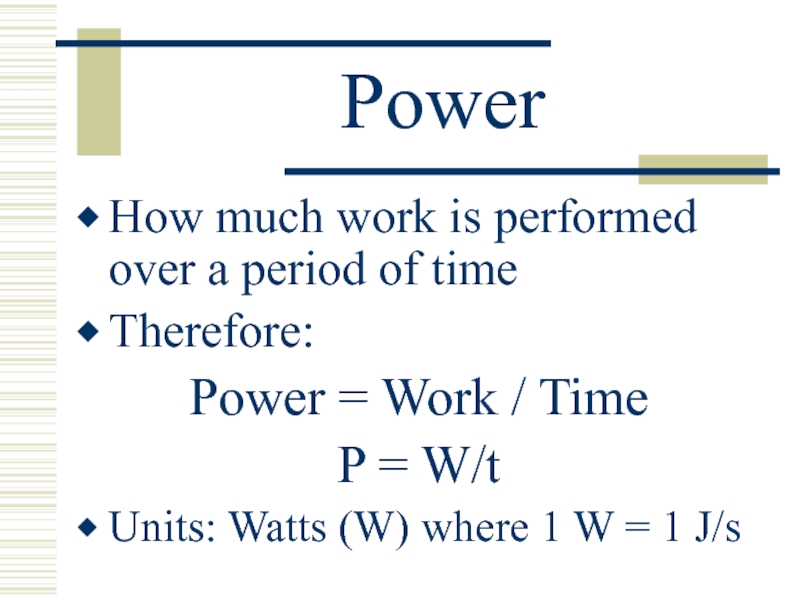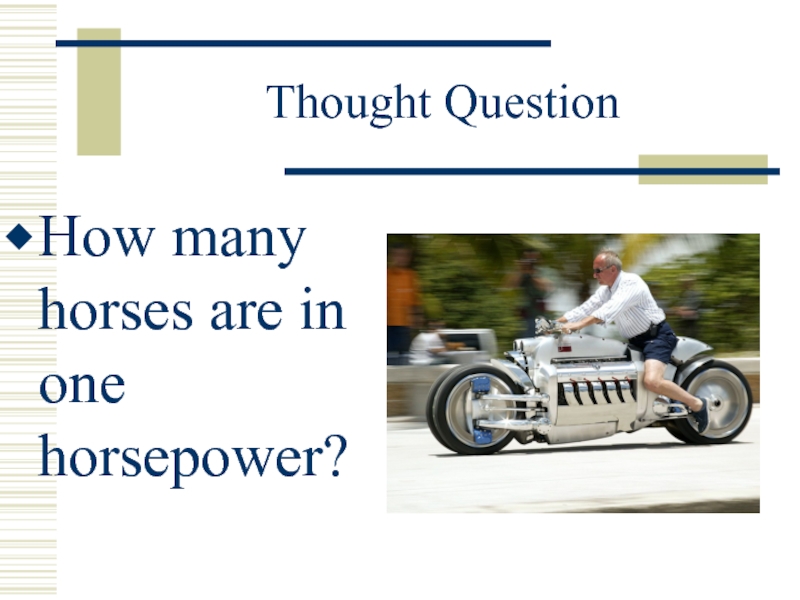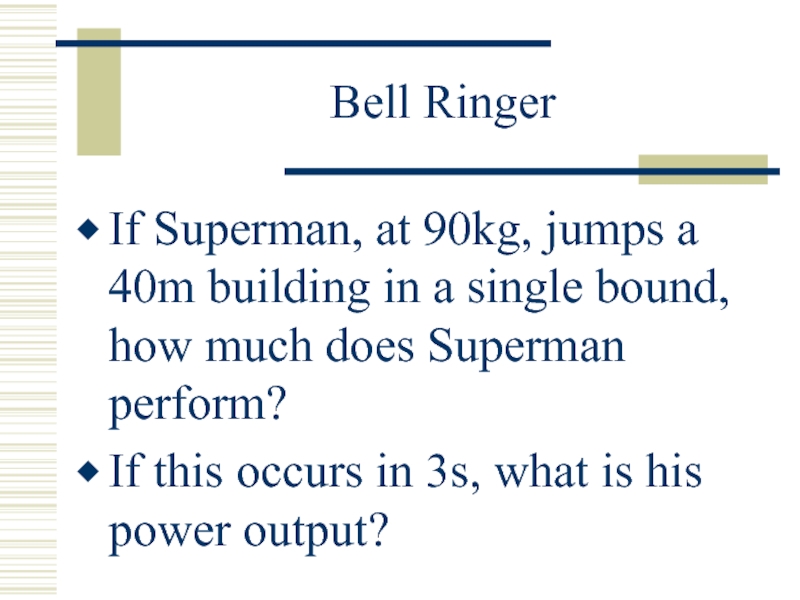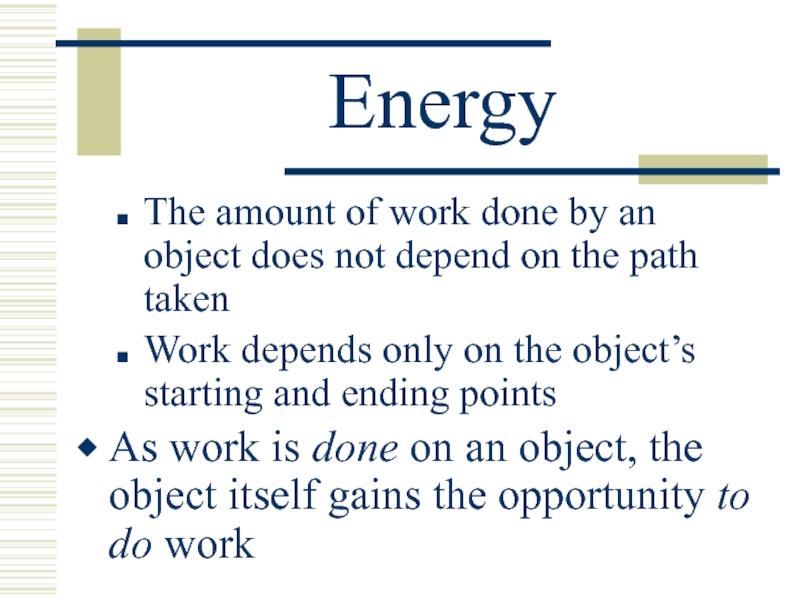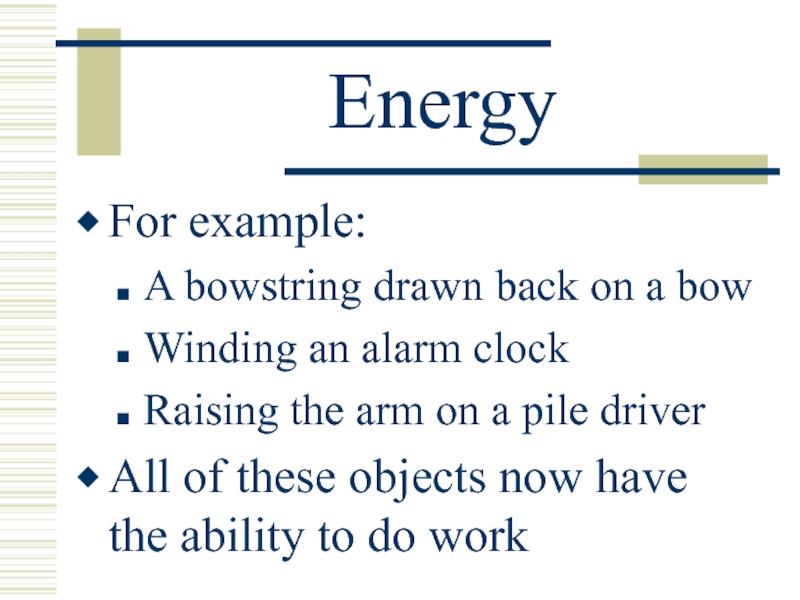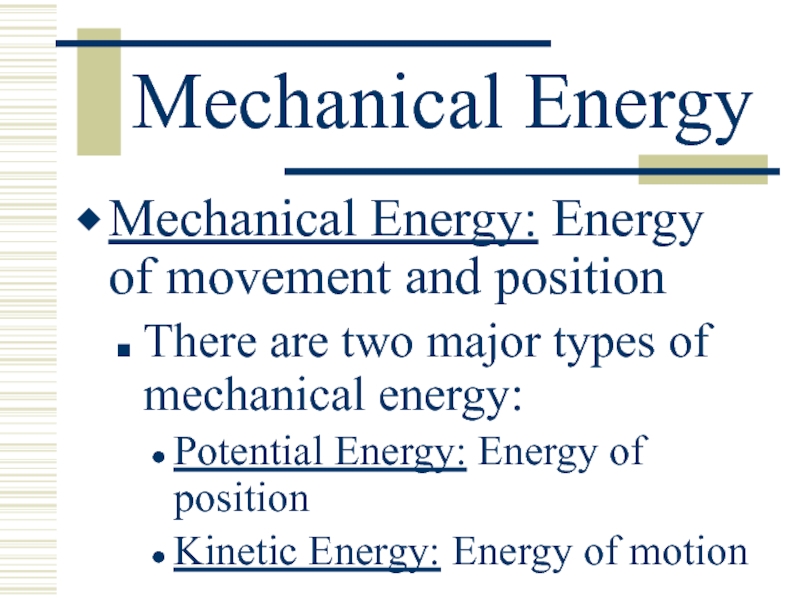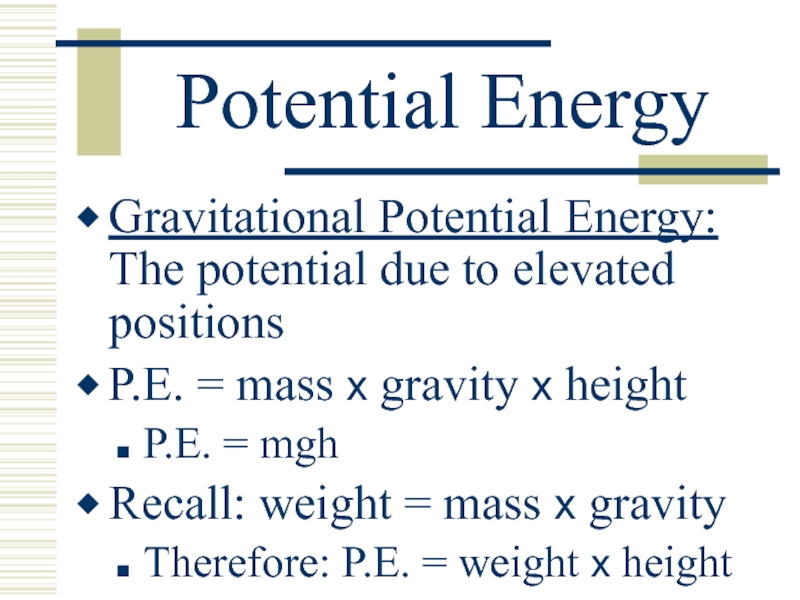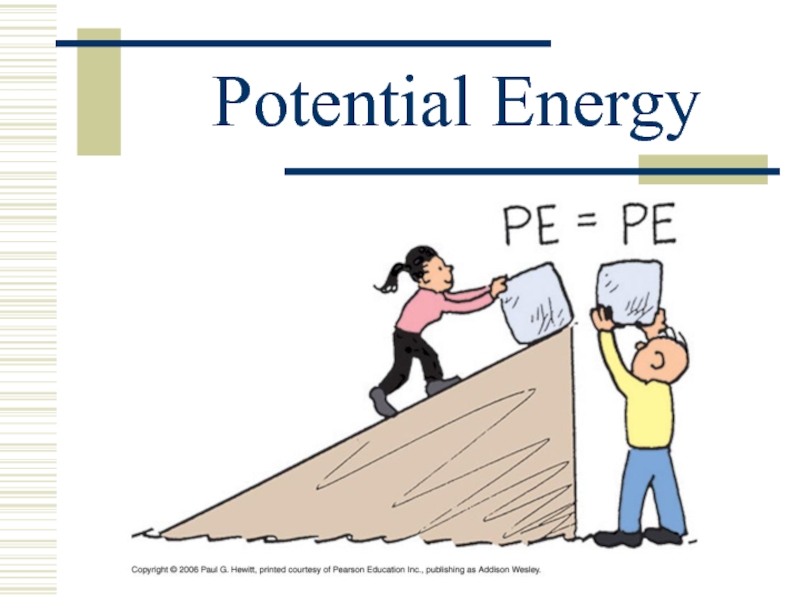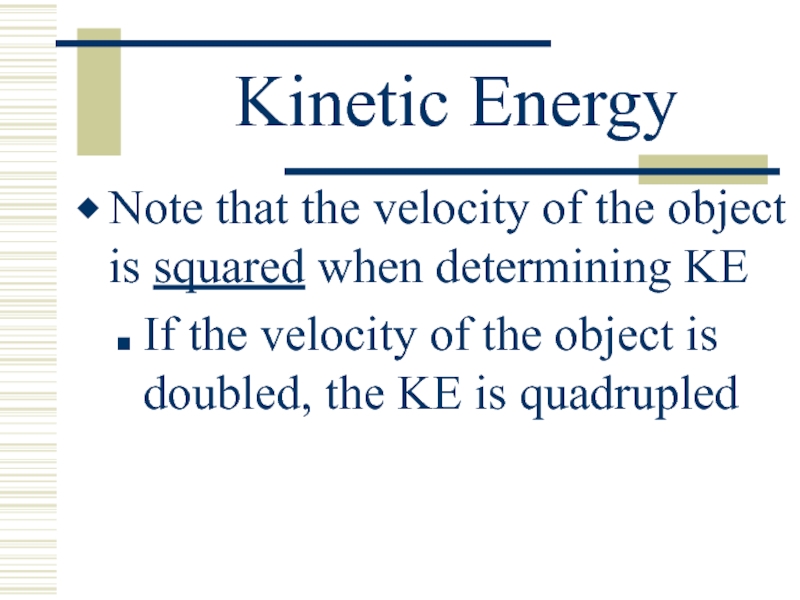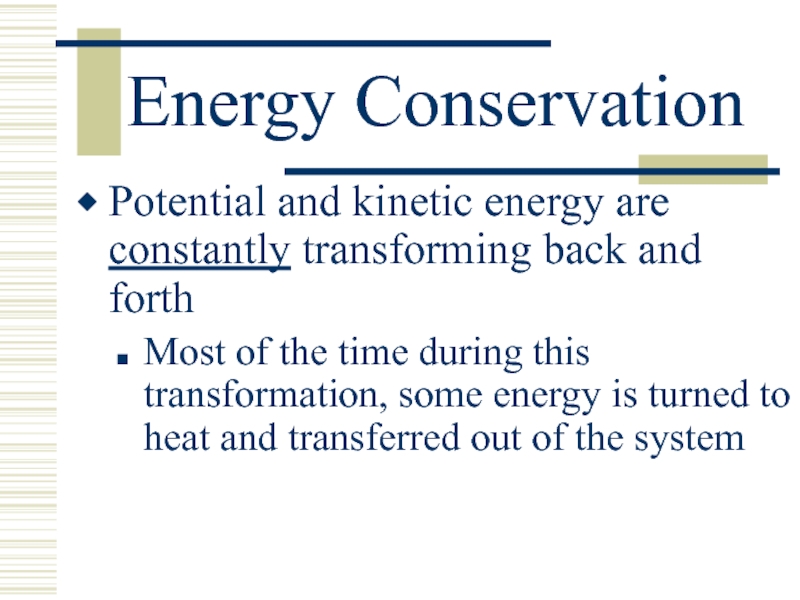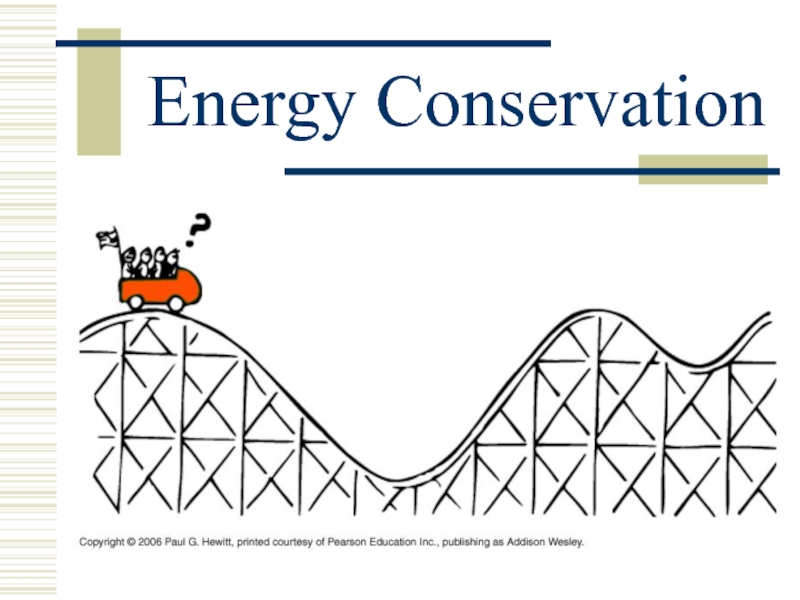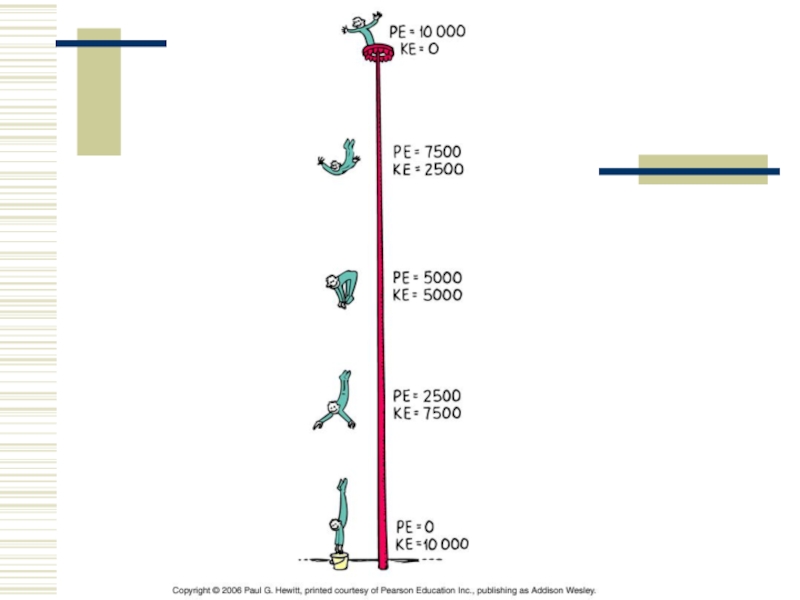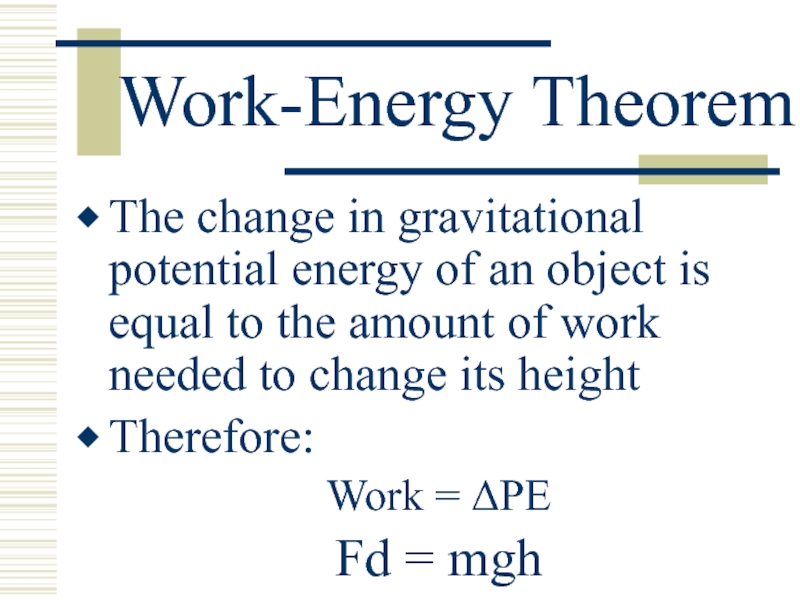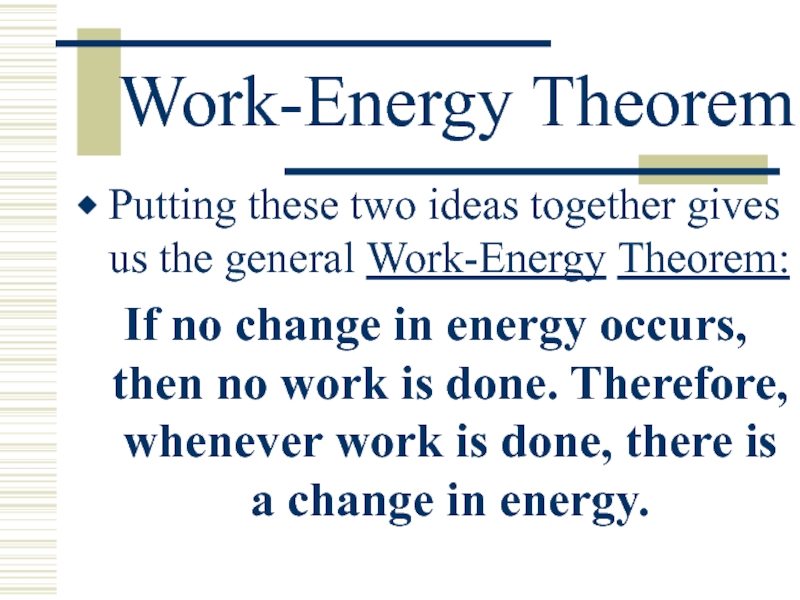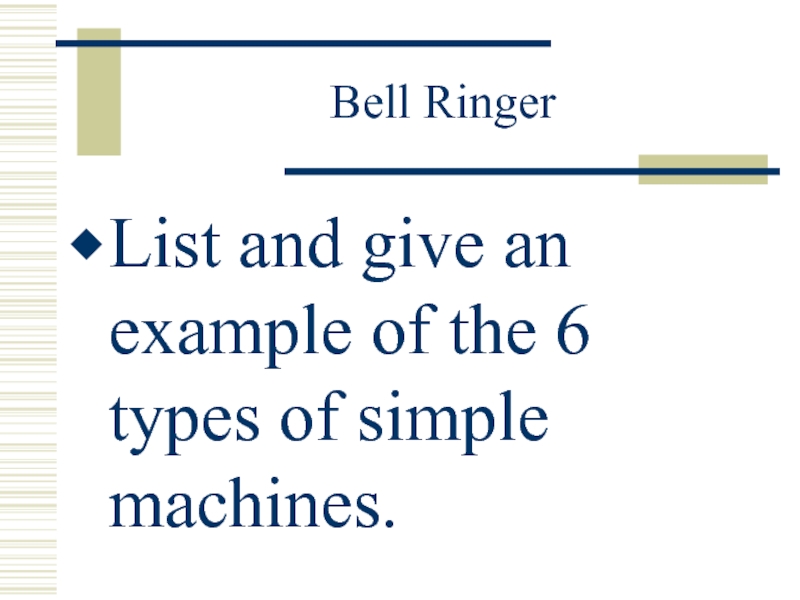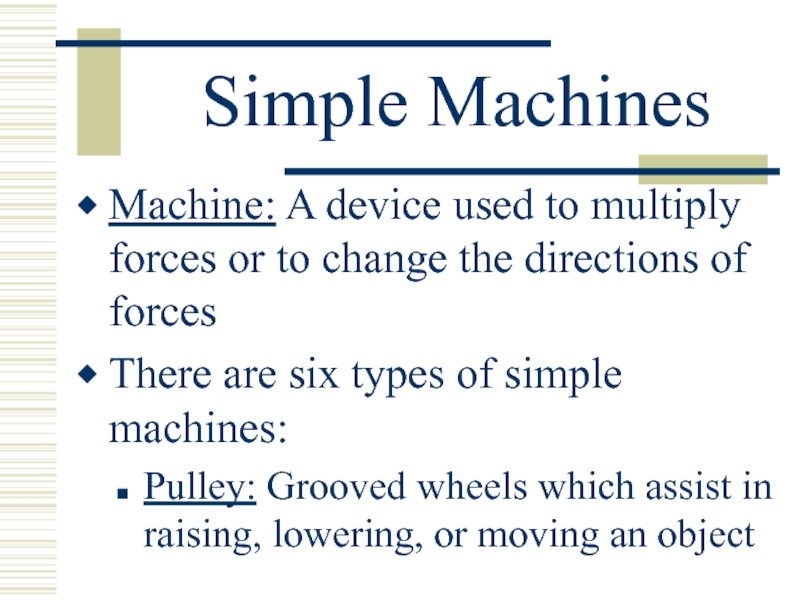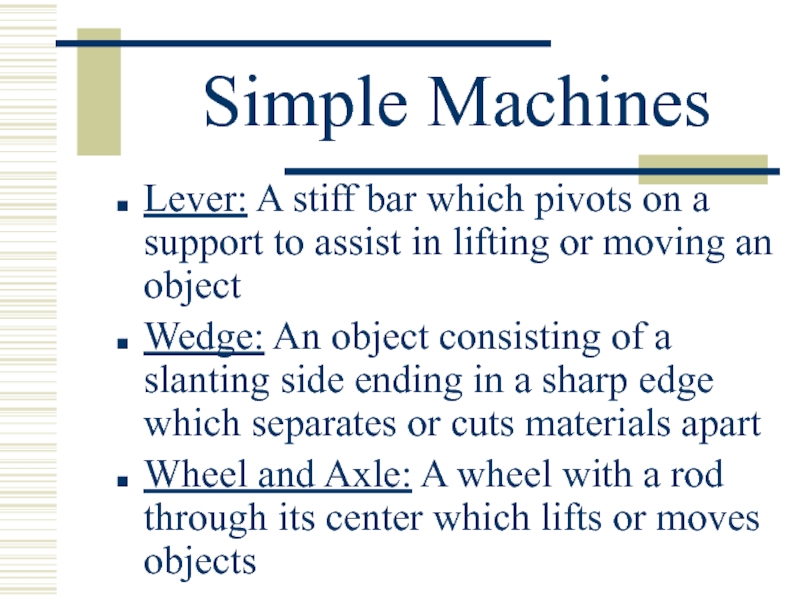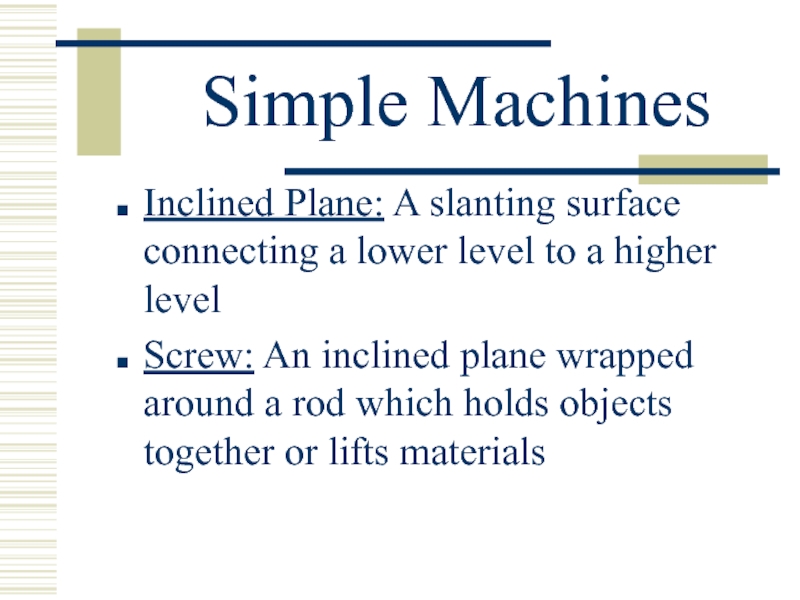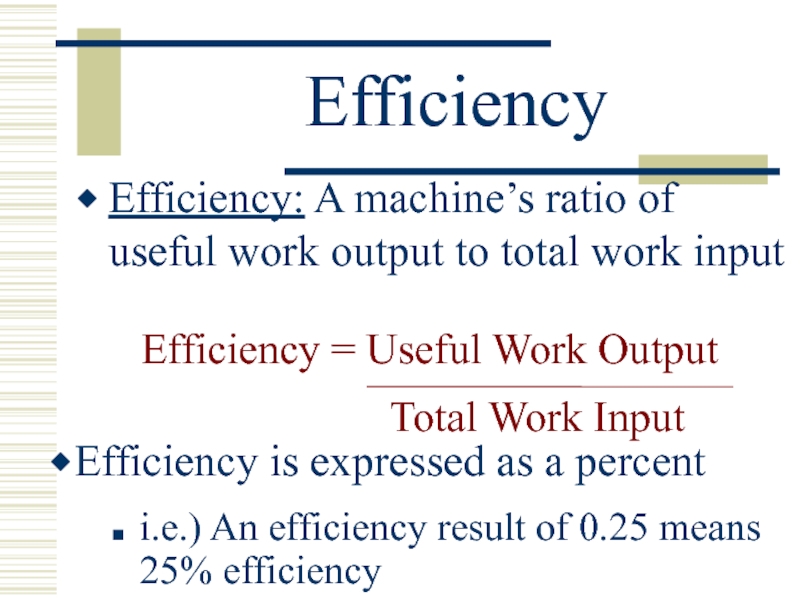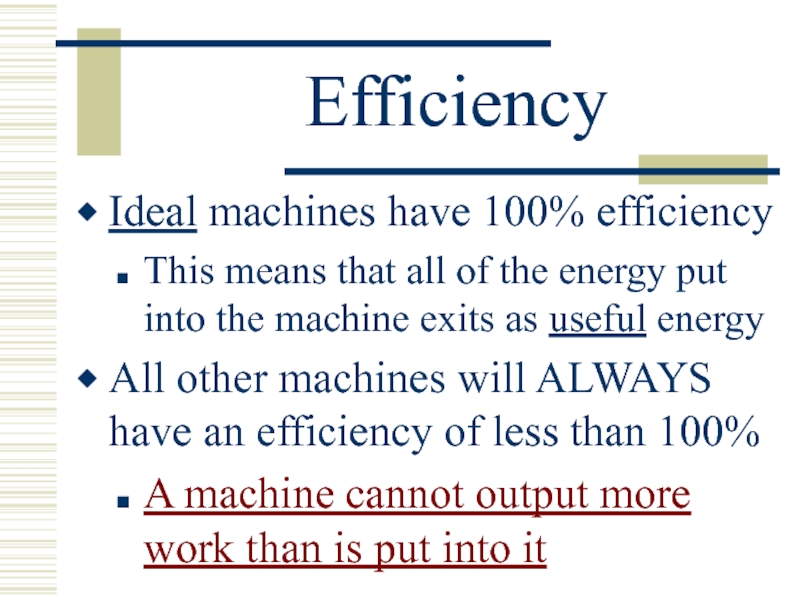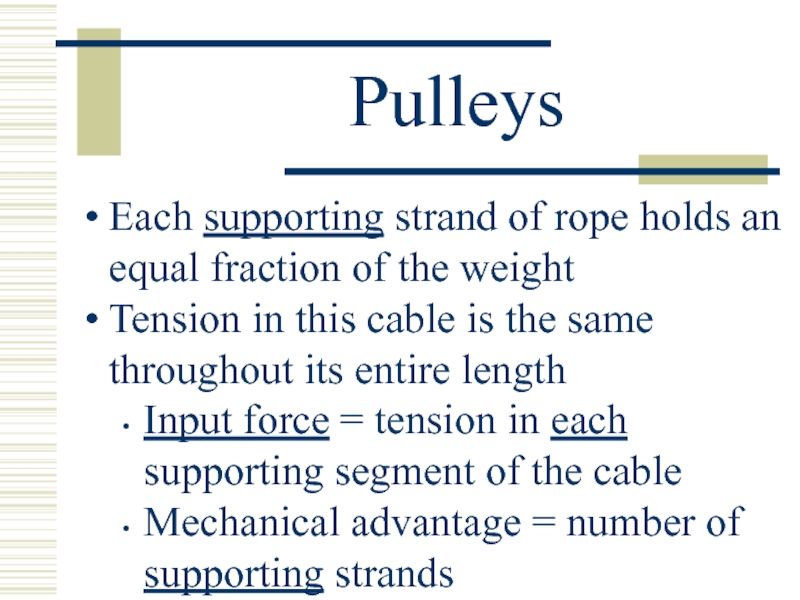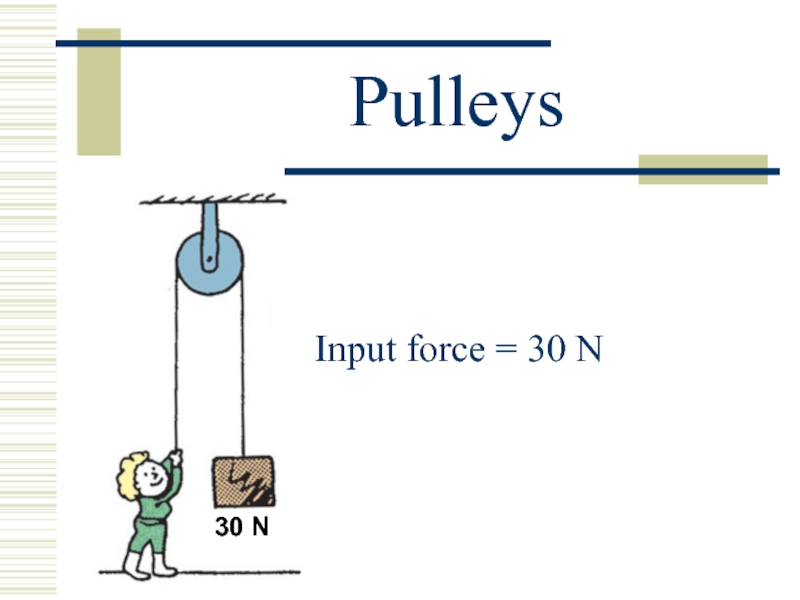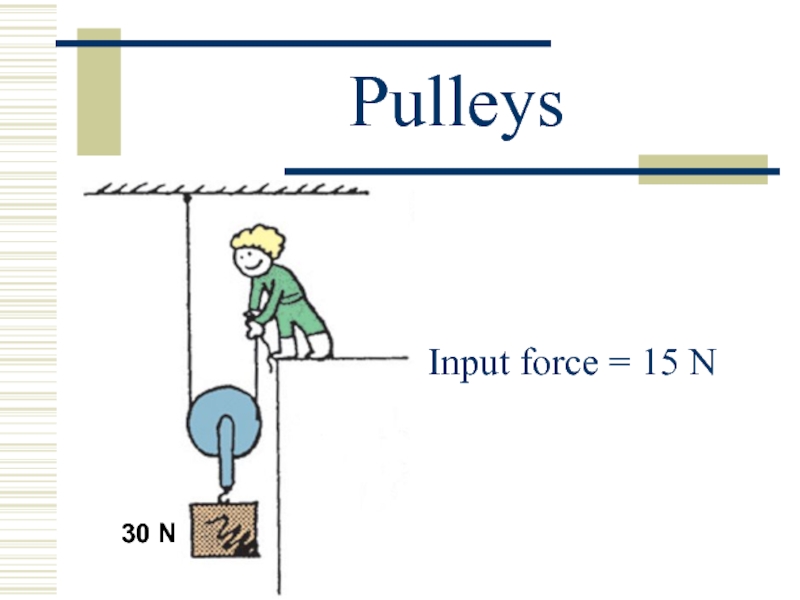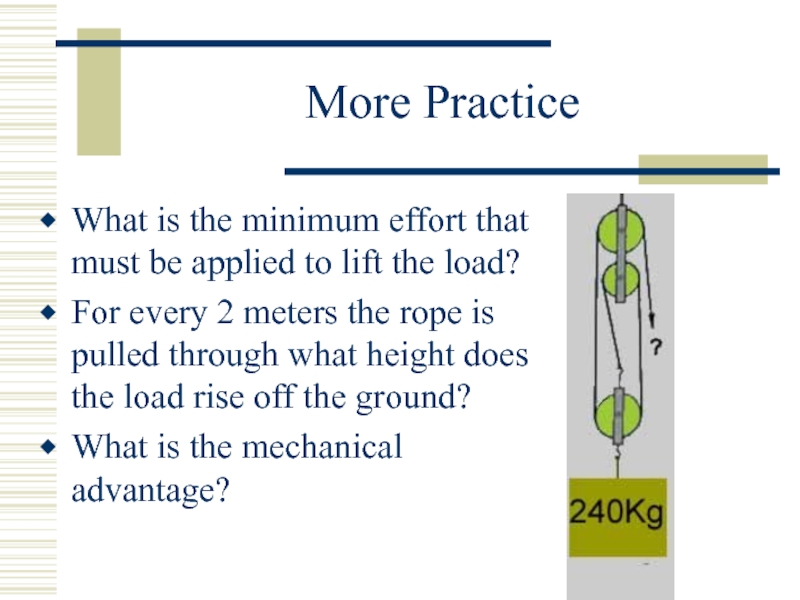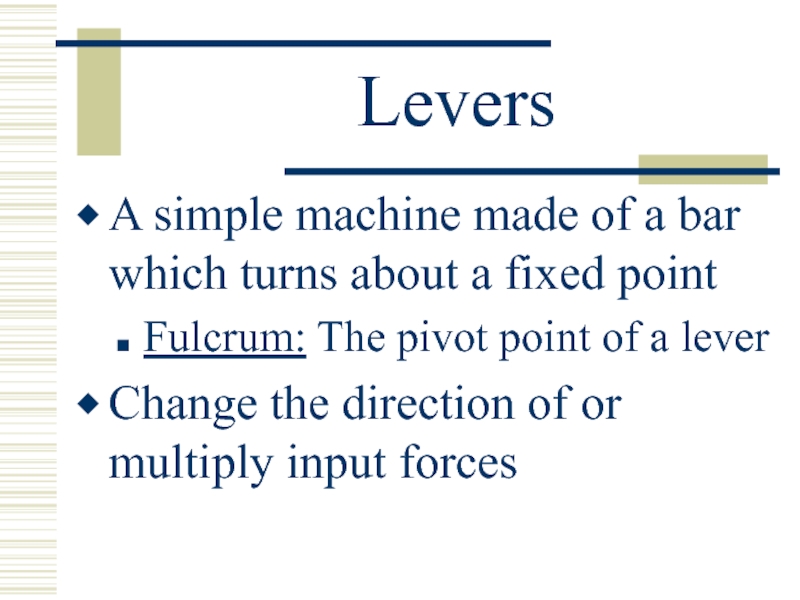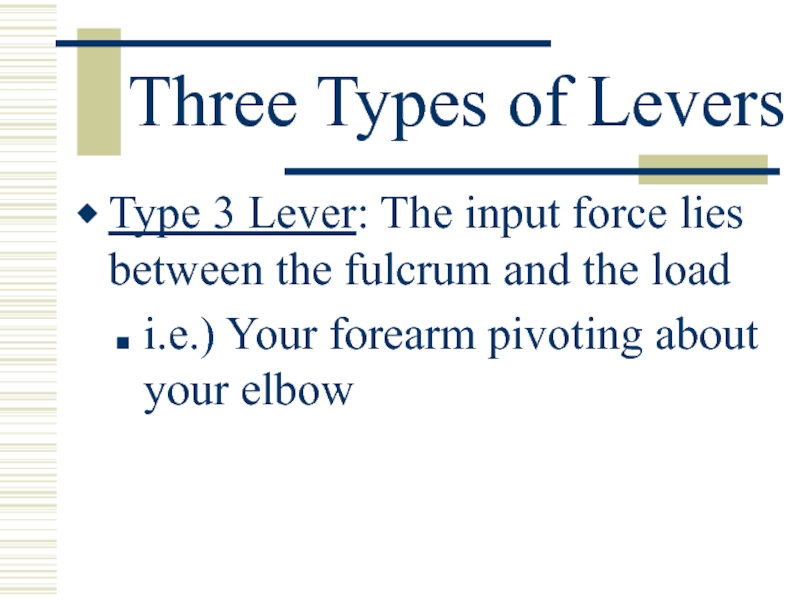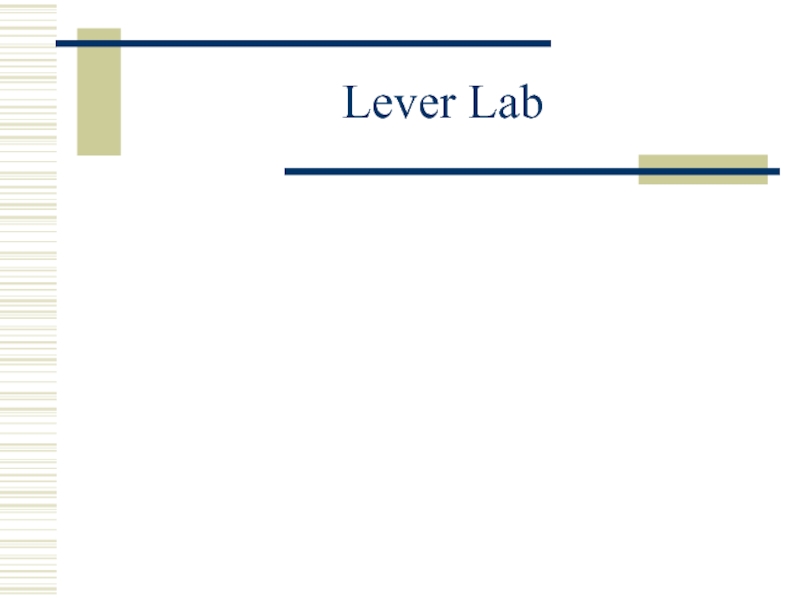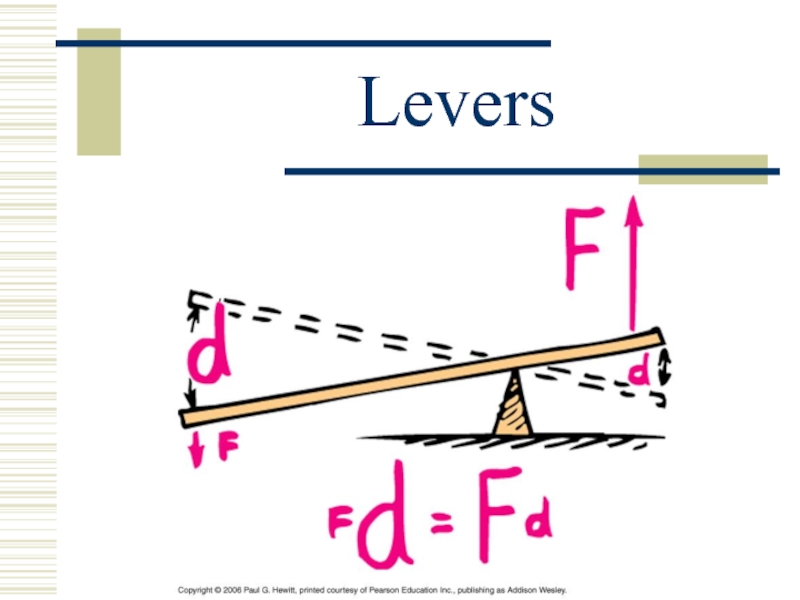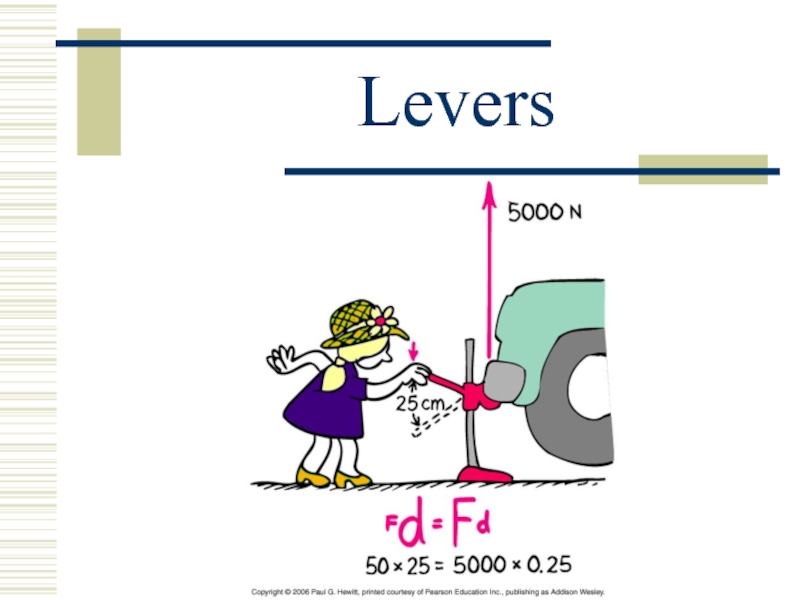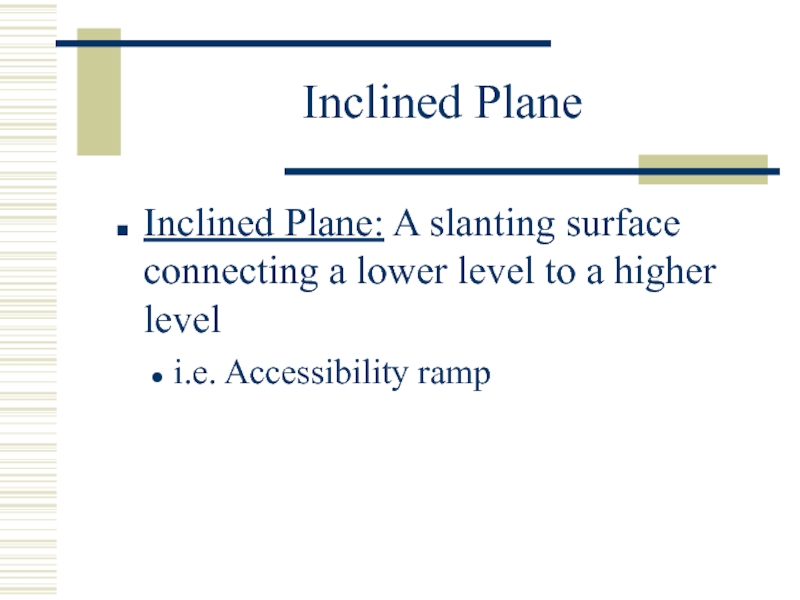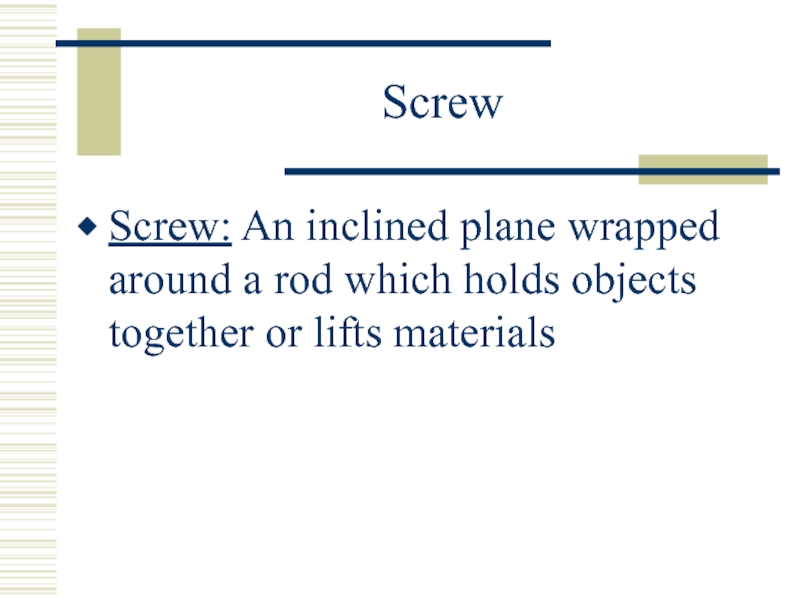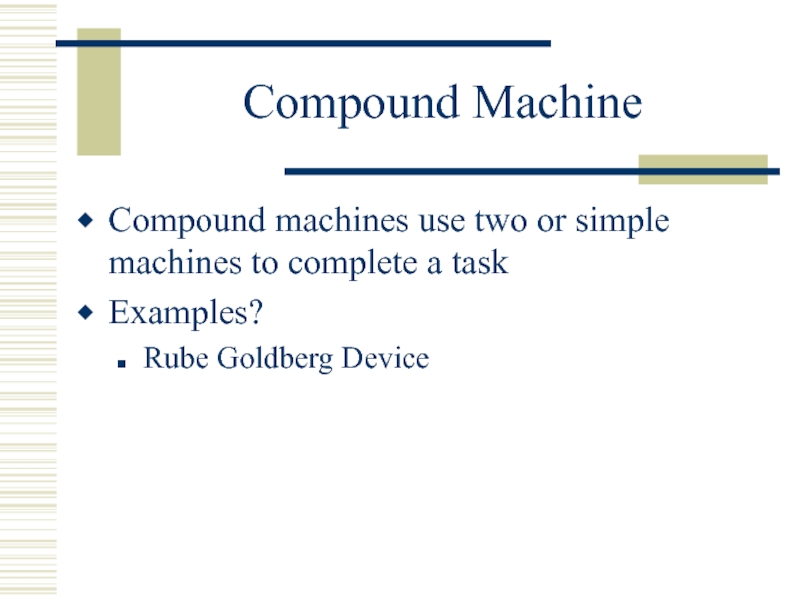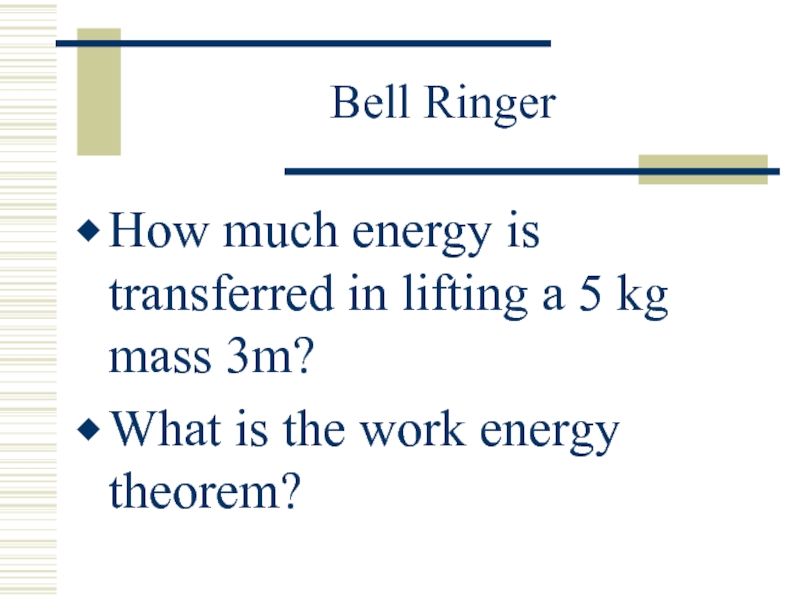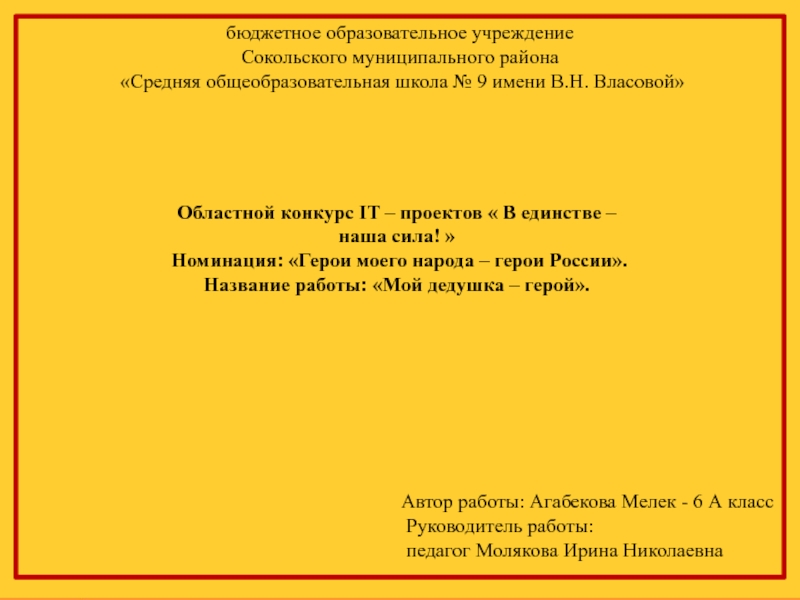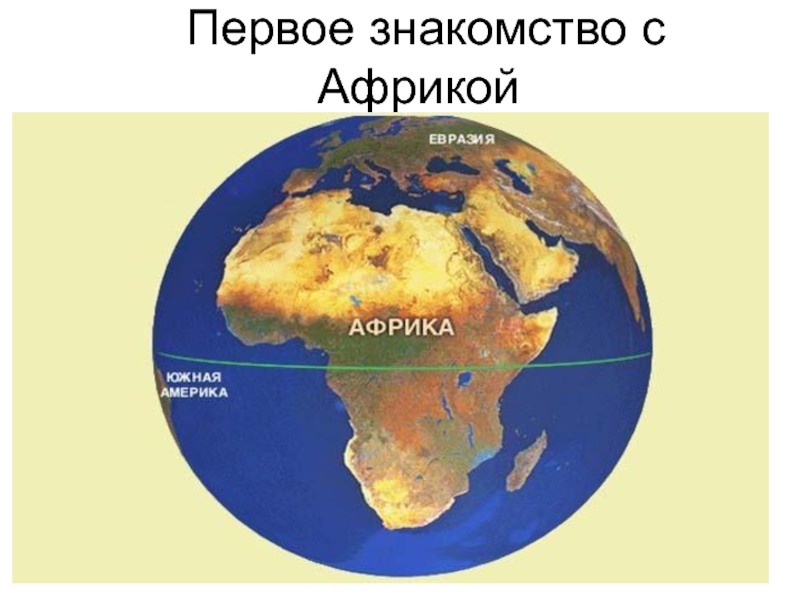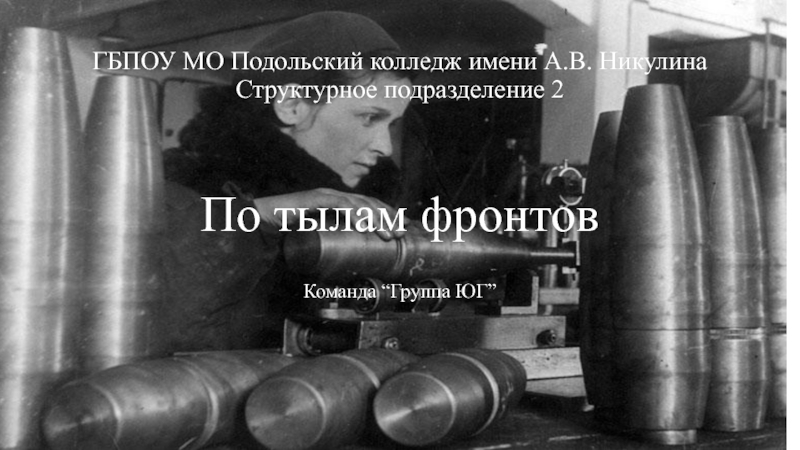Разделы презентаций
- Разное
- Английский язык
- Астрономия
- Алгебра
- Биология
- География
- Геометрия
- Детские презентации
- Информатика
- История
- Литература
- Математика
- Медицина
- Менеджмент
- Музыка
- МХК
- Немецкий язык
- ОБЖ
- Обществознание
- Окружающий мир
- Педагогика
- Русский язык
- Технология
- Физика
- Философия
- Химия
- Шаблоны, картинки для презентаций
- Экология
- Экономика
- Юриспруденция
Bell Ringer
Содержание
- 1. Bell Ringer
- 2. Bell Ringer 10/25What is another term for the ability to do work?
- 3. EnergyEnergy: The ability of an object to
- 4. EnergyThermal: “Heat energy” stored in materials at
- 5. WorkWork is done when a task produces
- 6. Bell RingerHow much work is required to lift a 2kg object 2m high?
- 7. WorkTherefore:Work = Force x DistanceW = FdUnits:
- 8. Bell Ringer 3/31What is another term for
- 9. Bell Ringer
- 10. PowerHow much work is performed over a
- 11. Thought QuestionHow many horses are in one horsepower?
- 12. PowerPower can also be converted to units of horsepower (hp)Note: 1 hp 750 W
- 13. Bell RingerIf Superman, at 90kg, jumps a
- 14. EnergyThe amount of work done by an
- 15. EnergyFor example:A bowstring drawn back on a
- 16. Mechanical EnergyMechanical Energy: Energy of movement and
- 17. Potential EnergyGravitational Potential Energy: The potential due
- 18. Potential Energy
- 19. Kinetic Energy Objects in motion are capable of doing workKE = ½.mass.velocity2 KE = ½mv2
- 20. Kinetic Energy Note that the velocity of
- 21. Energy ConservationEnergy is constantly transforming, but never
- 22. Energy ConservationPotential and kinetic energy are
- 23. Energy Conservation
- 24. Слайд 24
- 25. Bell RingerJill has a velocity of 5m/s.
- 26. Work-Energy Theorem The change in gravitational potential
- 27. Work-Energy Theorem The KE of a moving
- 28. Work-Energy Theorem Putting these two ideas together
- 29. Bell RingerList and give an example of the 6 types of simple machines.
- 30. Simple Machines Machine: A device used to
- 31. Simple Machines Lever: A stiff bar which
- 32. Simple Machines Inclined Plane: A slanting surface
- 33. Bell RingerWhat is an example of a 100% efficient machine?
- 34. Mechanical Advantage Mechanical Advantage: A machine’s ratio
- 35. Efficiency Efficiency: A machine’s ratio of useful
- 36. Efficiency Ideal machines have 100% efficiencyThis means
- 37. PulleysSingle Pulley:Changes the direction of a force
- 38. PulleysEach supporting strand of rope holds an
- 39. Pulleys30 NInput force = 30 N
- 40. PulleysInput force = 15 N30 N
- 41. Bell RingerHow many supporting strands are there
- 42. More PracticeWhat is the minimum effort that
- 43. LEVERS
- 44. LeversA simple machine made of a bar
- 45. Three Types of LeversType 1 Lever: Fulcrum
- 46. Three Types of LeversType 3 Lever: The
- 47. Lever Lab
- 48. LeversIf friction is small enough to neglect:Work
- 49. Levers
- 50. Levers
- 51. WedgeWedge: An object consisting of a slanting
- 52. Wheel and AxelWheel and Axle: A wheel
- 53. Inclined PlaneInclined Plane: A slanting surface connecting a lower level to a higher leveli.e. Accessibility ramp
- 54. ScrewScrew: An inclined plane wrapped around a rod which holds objects together or lifts materials
- 55. Compound MachineCompound machines use two or simple machines to complete a taskExamples?Rube Goldberg Device
- 56. Bell RingerHow much energy is transferred in
- 57. Скачать презентанцию
Bell Ringer 10/25What is another term for the ability to do work?
Слайды и текст этой презентации
Слайд 3Energy
Energy: The ability of an object to do work
Units: Joules
(J)
Types of energy include:
Mechanical: Energy of movement and position
Chemical: Energy
stored in chemical bonds of moleculesСлайд 4Energy
Thermal: “Heat energy” stored in materials at a certain temperature
Nuclear:
Energy produced from the splitting of atoms
Radiant Energy: Energy traveling
the form of electromagnetic wavesElectric Energy: Energy traveling as the flow of charged particles (i.e. electrons)
Слайд 5Work
Work is done when a task produces a change in
energy
Factors affecting work done:
The application of a force
The movement of
the object by that force over a distanceСлайд 7Work
Therefore:
Work = Force x Distance
W = Fd
Units: Joule (J)
1
J = 1 N.m
Note that work requires a distance
Слайд 8Bell Ringer 3/31
What is another term for the ability to
do work?
You push a stationary wall with a force of
1000N. How much work was done to the wall?Слайд 10Power
How much work is performed over a period of time
Therefore:
Power
= Work / Time
P = W/t
Units: Watts (W) where 1
W = 1 J/sСлайд 13Bell Ringer
If Superman, at 90kg, jumps a 40m building in
a single bound, how much does Superman perform?
If this occurs
in 3s, what is his power output?Слайд 14Energy
The amount of work done by an object does not
depend on the path taken
Work depends only on the object’s
starting and ending pointsAs work is done on an object, the object itself gains the opportunity to do work
Слайд 15Energy
For example:
A bowstring drawn back on a bow
Winding an alarm
clock
Raising the arm on a pile driver
All of these objects
now have the ability to do workСлайд 16Mechanical Energy
Mechanical Energy: Energy of movement and position
There are two
major types of mechanical energy:
Potential Energy: Energy of position
Kinetic Energy:
Energy of motionСлайд 17Potential Energy
Gravitational Potential Energy: The potential due to elevated positions
P.E.
= mass x gravity x height
P.E. = mgh
Recall: weight =
mass x gravityTherefore: P.E. = weight x height
Слайд 20Kinetic Energy
Note that the velocity of the object is
squared when determining KE
If the velocity of the object is
doubled, the KE is quadrupledСлайд 21Energy Conservation
Energy is constantly transforming, but never “disappears”
Law of Conservation
of Energy: Energy cannot be created or destroyed, only changed
from one form to another.Слайд 22 Energy Conservation
Potential and kinetic energy are constantly transforming back
and forth
Most of the time during this transformation, some energy
is turned to heat and transferred out of the systemСлайд 25Bell Ringer
Jill has a velocity of 5m/s. If she has
a mass of 60kg, what is her kinetic energy?
If Bob,
at 70kg, is standing on top of a 13m high hill. What is his potential energy?Слайд 26Work-Energy Theorem
The change in gravitational potential energy of an
object is equal to the amount of work needed to
change its heightTherefore:
Work = DPE
Fd = mgh
Слайд 27Work-Energy Theorem
The KE of a moving object is equal
to the work the object is capable of doing while
being brought to restTherefore:
W = DKE or Fd = ½mv2
Слайд 28Work-Energy Theorem
Putting these two ideas together gives us the
general Work-Energy Theorem:
If no change in energy occurs, then no
work is done. Therefore, whenever work is done, there is a change in energy.Слайд 30Simple Machines
Machine: A device used to multiply forces or
to change the directions of forces
There are six types of
simple machines:Pulley: Grooved wheels which assist in raising, lowering, or moving an object
Слайд 31Simple Machines
Lever: A stiff bar which pivots on a
support to assist in lifting or moving an object
Wedge: An
object consisting of a slanting side ending in a sharp edge which separates or cuts materials apartWheel and Axle: A wheel with a rod through its center which lifts or moves objects
Слайд 32Simple Machines
Inclined Plane: A slanting surface connecting a lower
level to a higher level
Screw: An inclined plane wrapped around
a rod which holds objects together or lifts materialsСлайд 34Mechanical Advantage
Mechanical Advantage: A machine’s ratio of output force
to input force
Mechanical Advantage = Output Force
Input Forcei.e. A machine which outputs 80 N for every 10 N you put in has a mechanical advantage of 8.
Note that the load will move only 1/8 of the input distance
Слайд 35Efficiency
Efficiency: A machine’s ratio of useful work output to
total work input
Efficiency = Useful Work Output
Total Work InputEfficiency is expressed as a percent
i.e.) An efficiency result of 0.25 means 25% efficiency
Слайд 36Efficiency
Ideal machines have 100% efficiency
This means that all of
the energy put into the machine exits as useful energy
All
other machines will ALWAYS have an efficiency of less than 100%A machine cannot output more work than is put into it
Слайд 37Pulleys
Single Pulley:
Changes the direction of a force exerted by a
rope or cable
System of pulleys:
Multiplies input forces, creating large
output forcesСлайд 38Pulleys
Each supporting strand of rope holds an equal fraction of
the weight
Tension in this cable is the same throughout
its entire lengthInput force = tension in each supporting segment of the cable
Mechanical advantage = number of supporting strands
Слайд 41Bell Ringer
How many supporting strands are there ?
What is the
Mechanical advantage here equal to?
What is the input force required
to lift the 200kg object?Слайд 42More Practice
What is the minimum effort that must be applied
to lift the load?
For every 2 meters the rope is
pulled through what height does the load rise off the ground?What is the mechanical advantage?
Слайд 44Levers
A simple machine made of a bar which turns about
a fixed point
Fulcrum: The pivot point of a lever
Change the
direction of or multiply input forcesСлайд 45Three Types of Levers
Type 1 Lever: Fulcrum lies between the
input force and the load
i.e.) A seesaw
Type 2 Lever: The
load lies between the fulcrum and the input forcei.e.) A pry bar

